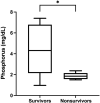Refeeding syndrome in small ruminants receiving parenteral nutrition
- PMID: 32588478
- PMCID: PMC7379001
- DOI: 10.1111/jvim.15840
Refeeding syndrome in small ruminants receiving parenteral nutrition
Abstract
Background: Small ruminants presented to tertiary care facilities commonly suffer from severe protein-calorie malnutrition. Some of these patients require parenteral nutrition (PN; amino acids and dextrose with or without lipids) during hospitalization. Refeeding syndrome, a potentially fatal shift of electrolytes seen in malnourished patients during refeeding, may occur.
Objective: (a) To report the prevalence of refeeding syndrome in small ruminants receiving PN and (b) to determine risk factors for the development of refeeding syndrome.
Animals: Hospitalized small ruminants (n = 20) that received PN from 2010 to 2018 and that had serial (≥2) monitoring of serum electrolyte concentrations after initiation of PN.
Methods: Retrospective case series. Refeeding syndrome was defined as the presence of at least 2 of the following electrolyte abnormalities after initiation of PN: hypophosphatemia, hypokalemia, hypomagnesemia, or some combination of these. Data was analyzed using Fisher's exact test, followed by univariate logistic regression.
Results: Eleven of 20 (55%) animals met the definition of refeeding syndrome. Mean minimum serum phosphorus concentration in animals with refeeding syndrome was 1.96 ± 0.69 mg/dL (reference range, 4.2-7.6 mg/dL). Eleven of 20 animals survived to discharge. Survival rate did not differ significantly between refeeding cases (4/11, 36.3%) and nonrefeeding cases (7/9, 77.8%; P = .09). Mean serum phosphorus concentration was significantly lower in nonsurvivors than in survivors (1.88 ± 0.10 mg/dL vs 4.32 ± 0.70 mg/dL, P = .006).
Conclusions and clinical importance: We report the prevalence of refeeding syndrome in small ruminants receiving PN. Clinicians should anticipate refeeding syndrome after initiation of PN and consider pre-emptive supplementation with phosphorus, potassium, magnesium, or some combination of these.
Keywords: hypokalemia; hypomagnesemia; hypophosphatemia; malnutrition.
© 2020 The Authors. Journal of Veterinary Internal Medicine published by Wiley Periodicals, Inc. on behalf of the American College of Veterinary Internal Medicine.
Conflict of interest statement
Authors declare no conflict of interest.
Figures

Comment in
-
Refeeding syndrome is common in small ruminants receiving parenteral nutrition.Vet Rec. 2020 Jul;187(2):72. doi: 10.1136/vr.m2969. Vet Rec. 2020. PMID: 33638397 No abstract available.
Similar articles
-
Hypophosphatemia, Hypomagnesemia, and Hypokalemia in Pediatric Patients Before and During Exclusive Individualized Parenteral Nutrition.Nutr Clin Pract. 2016 Apr;31(2):223-8. doi: 10.1177/0884533615627266. Epub 2016 Feb 11. Nutr Clin Pract. 2016. PMID: 26869613
-
Higher caloric intake in hospitalized adolescents with anorexia nervosa is associated with reduced length of stay and no increased rate of refeeding syndrome.J Adolesc Health. 2013 Nov;53(5):573-8. doi: 10.1016/j.jadohealth.2013.05.014. Epub 2013 Jul 3. J Adolesc Health. 2013. PMID: 23830088
-
RETROSPECTIVE EVALUATION OF THE USE OF PARENTERAL NUTRITION IN HOSPITALIZED NONDOMESTIC RUMINANTS.J Zoo Wildl Med. 2020 Jan 9;50(4):853-860. doi: 10.1638/2019-0034. J Zoo Wildl Med. 2020. PMID: 31926515
-
Refeeding syndrome: screening, incidence, and treatment during parenteral nutrition.J Gastroenterol Hepatol. 2013 Dec;28 Suppl 4:113-7. doi: 10.1111/jgh.12345. J Gastroenterol Hepatol. 2013. PMID: 24251716 Review.
-
Recognizing and preventing refeeding syndrome.Dimens Crit Care Nurs. 2009 Mar-Apr;28(2):53-8; quiz 59-60. doi: 10.1097/DCC.0b013e318195d3e0. Dimens Crit Care Nurs. 2009. PMID: 19225312 Review.
Cited by
-
Retrospective evaluation of refeeding syndrome in cats: 11 cases (2013-2019).J Feline Med Surg. 2021 Oct;23(10):883-891. doi: 10.1177/1098612X20979706. Epub 2021 Jan 6. J Feline Med Surg. 2021. PMID: 33404281 Free PMC article.
-
Fasting durations of Steller sea lion pups vary among subpopulations-evidence from two plasma metabolites.Conserv Physiol. 2023 Nov 24;11(1):coad084. doi: 10.1093/conphys/coad084. eCollection 2023. Conserv Physiol. 2023. PMID: 38026798 Free PMC article.
References
-
- Schnitker MA, Mattman PE, Bliss TL. A clinical study of malnutrition in Japanese prisoners of war. Ann Intern Med. 1951;35:69‐96. - PubMed
-
- Crook MA, Hally V, Panteli JV. The importance of the refeeding syndrome. Nutrition. 2001;17:632‐637. - PubMed
-
- Kraaijenbrink BV, Lambers WM, Mathus‐Vliegen EM, Siegert CE. Incidence of refeeding syndrome in internal medicine patients. Neth J Med. 2016;74:116‐121. - PubMed
MeSH terms
Substances
LinkOut - more resources
Full Text Sources
Miscellaneous

